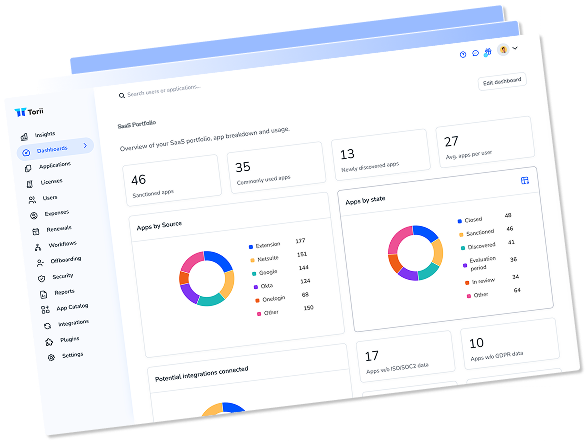“Finance is not merely about making money. It’s about achieving our deep goals and protecting the fruits of our labor.” — Robert J. Shiller
Finance is often seen as the villain or roadblock, only acknowledged when they’re cutting budgets or blocking expense approvals. However, any reasonable professional will recognize that the finance team is carrying an incredible amount of responsibility. Without their steady hand to ensure fiscal responsibility and long-term sustainability—everyone else’s job and paycheck would come to a quick end.
For IT, collaboration with Finance is typically infrequent. And when they do meet, their priorities are usually different. IT focuses on functionality, operational efficiency, security, and maintaining good support throughout the organization—this often requires tools or staff that can cost a fair bit. Finance, on the other hand, is focused on cutting costs to maintain the right balance of value relative to function. The tension often emerges as IT and Finance disagree about whether or not a resource is worth the price tag.
In this piece, we’re going to examine how IT can build a bridge between these two groups based on understanding. Remember, the goal of this series is to earn buy-in for your IT project—but not in a way that deceives or circumvents your coworkers. Rather, the goal is to educate and help other teams get more value out of the tool (in this case, a SaaS Management Platform) so that you not only gain buy-in and budget but also elevate the whole organization’s efficiency and cost-effectiveness as it relates to SaaS.
But before you can engage your finance colleagues effectively, you need to understand what matters most to them.
Finance Professionals: The Stewards
What they care about: Cost Optimization and Spend Management, Visibility and Compliance, Financial Planning and Forecasting.
Your finance colleagues are busy, so when you introduce SaaS Management, focus on what matters to them! Highlight how a SaaS Management Platform (SMP) will aid their priorities of cost optimization, spend management, visibility, compliance, and financial planning. Yes, there are plenty of other benefits, but when addressing other teams, stay sensitive to their priorities. An SMP provides financial insights and controls that no other tool offers, helping finance teams monitor expenses, eliminate wasteful spending, ensure compliance with licensing agreements, and make accurate forecasts.
Key Priorities for Finance:
1. Cost Optimization and Spend Management
They need visibility to inform cost optimization and spend management: Your finance team needs accurate insight into all software spending across the organization. Unfortunately, many organizations struggle with duplicate contracts, shadow IT expenses, and underutilized licenses. These issues lead to continuous budget overruns.
When communicating with Finance peers, remember that they care as much about shadow IT as you do, but their primary concern is how it undermines financial planning. Shadow apps draw shadow expenses, and they often replace paid apps. That means that, from a finance perspective, when someone is adopting an unsanctioned app, they might also be abandoning a sanctioned and expensive app.
They want to know “have we invested in the best allocation of resources?”
With a SaaS Management Platform (SMP) like Torii, you can start connecting the dots between active costs and apps. Here are some things that Finance can do with an SMP:
Real-time visibility: Nobody likes a surprise expense—especially when it upends the budget. SMPs are the only tools with real-time visibility and alerts about new app adoption before they even charge an expense. SMPs functionally become a live system of record for apps. Every app (sanctioned or not), every contract, and every expense is drawn into the SMP through various discovery sources and integrations. The result is a centralized view to see everything and then investigate further.
Compare costs vs usage: Finance doesn’t want to cut costs blindly. A SaaS Management Platform lets them see how many license seats are active, idle, and unassigned. That way, they can make data-driven decisions. In our Benchmark report, we found that some of the most popular apps commonly have non-utilization rates above 25% (that’s a lot of potential savings).
Benchmark your spending: Torii offers benchmark data for apps, allowing you to compare your SaaS spending with industry averages and peer organizations. This insight helps you understand if you’re overspending on certain applications compared to others in your industry, enabling more strategic budgeting and vendor negotiations.
App comparison: You’ve definitely got some redundancy in your tech stack. Now, you can reduce or eliminate it with confidence. Torii creates AI generated comparison reports for similar apps. For example, if your company has contracts for Asana, Monday, and Trello, you can get a side by side look at the contract terms, utilization rates, usage trends, extra expenses, and more. You can even identify every user with licenses for more than one tool.
Contract Management tools: Torii also includes a suite of tools specifically for contract management from
- AI parsing of contract PDFs
- Integrations with Zip, Ironclad, and PandaDoc
- Renewal and auto-renewal alerts
- Yearly renewal summary reports
- Shareable renewals calendars
- And more
We’ll cover these in more depth in a Procurement-focused article.
2. Visibility and Compliance
Ensure compliance and avoid penalties: Finance teams are responsible for making sure the organization’s software usage complies with licensing agreements to prevent unexpected fees or legal issues.
Again, an SMP provides a centralized license repository so everyone can see their inventory in real-time. This means Finance has visibility into utilization rates on aggregate and user-specific insights. With this information, your organization mitigates the risk of violating license agreements and avoiding costly penalties.
Integration with financial systems: An SMP like Torii can also integrate with your existing financial tools like Expensify, Netsuite, Concur, or Coupa to provide a unified view of SaaS expenditures, simplifying reporting and auditing processes.
3. Financial Planning and Forecasting
Support Accurate Budgeting and Forecasting: Finance teams rely on precise and reliable data to plan future budgets effectively. A SaaS Management Platform (SMP) like Torii provides that data on SaaS spending, enabling finance professionals to analyze usage trends and anticipate future costs. By leveraging this data, finance teams can create more accurate budgets that reflect actual software needs and usage patterns. Additionally, an SMP helps predict upcoming expenses related to renewals, price increases, and scaling requirements, ensuring that the organization is financially prepared for future software investments.
Align SaaS Investments with Business Objectives: Does your SaaS spending line up with strategic goals for the organization? With an SMP like Torii, Finance can see for itself if the apps match the goals. While this might not appeal to all finance pros, those with a more strategic mindset will love the breadth and depth of data at their fingertips. They’ll feel more informed about communication with internal stakeholders, board members, leadership, and vendors.
Yearly Renewals Summary: One of the standout features of Torii is the Renewals Yearly Summary Report. This simple waterfall chart tells the whole story of your annualized contract spend.
- Starting Annualized Costs: Understand the initial financial commitment for each SaaS application at the beginning of the year.
- Actions Taken: Track all financial actions related to SaaS management, including cancellations of unused licenses, expansions of necessary subscriptions, and the addition of new contracts to meet evolving business needs.
- Ending Annualized Contract Costs: See the final annualized costs after all adjustments, providing a transparent view of how SaaS spending has evolved throughout the year.
A chart like this provides information and context to Finance teams trying to understand spend within the organization.
Putting it all together—sample message:
Ok, you’re now equipped with a better understanding of your Finance team’s priorities and you know about the capabilities that matter to them and their goals. But how do you start the conversation?
First, know your contact.
Figure out who has the authority to back up this initiative and who would benefit from it’s success. A great contact would be someone who sees this technology as a way to better align IT with Finance’s initiatives. Hence, both groups have a better understanding of cost relative to value. Some example contacts would be the company’s Chief Financial Officer (CFO), Vice President of Finance (VP of Finance), and Finance Director. Additionally, you may have a Financial Controller or Financial Planning and Analysis (FP&A) Manager who would also be interested in how an SMP can benefit their work.
Existing rapport is best.
Your chances of success will improve the better your working relationship with this individual is. If you’ve shown a reputation for commitment to projects and reliability, you will have much more success when asking for support. After all, no one wants to back an erratic project owner.
Structure your message.
You’ve heard it before, but when you write a message to you colleague, you want to get to the point—fast. (They’re busy, remember). Use this template to structure your message:
Hi [team/name], 👋
[hook—why they should read on]
[state the shared problem or need]
[introduce your solution]
[provide relevant evidence or benefits]
[timeline or urgency]
[next steps]
[thanks]
Best,
[your name]
Now, let’s see how that looks in practice. You can use this message, but remember, a personalized message that relates to your team’s specifics will be much more effective!
Hey [Name], As our software stack keeps growing, it's becoming more challenging for IT to track all the apps people are adopting and expensing. I thought you might be facing similar issues on your end. I came across a tool called Torii, a SaaS Management Platform that could help us both get better visibility into software usage and costs. Here are a few features that stood out: - Real-Time Spend Monitoring: We can get instant alerts whenever new subscriptions are added or costs change, helping us avoid surprise expenses. - License Utilization Rates: It shows which apps are actually being used, allowing us to eliminate unused or redundant licenses and save money. - Benchmark Data: We can compare our SaaS spending against industry standards to ensure we're not overspending. I found a case study where Hired used Torii to save $1.7 million in SaaS spend: Hired Case Study. https://www.toriihq.com/case-studies/hired I believe Torii could help us optimize costs and align our spending with our financial goals. I'd like to discuss this with leadership for next quarter's budget and would value your input. Could we set up a quick chat soon? Thanks! Best, [Your Name]
One piece of the puzzle
In addition to Finance, you should have similar conversations with other organizational stakeholders. In every instance, the conversation should be kept relevant to their needs while also making it clear that the tool is ultimately what IT requires for managing SaaS. You’re not trying to replace any other tool; you’re trying to enhance everyone’s daily work because everyone’s work involves SaaS!
Ultimately, it’s about helping them gain visibility to evaluate whether you’re getting the best value from your costs.
Good luck!

